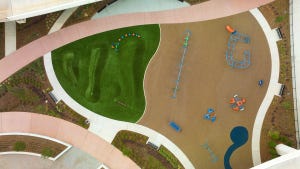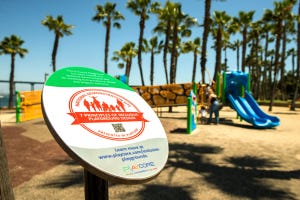Creating a play and recreation space for a neighborhood or homeowner's association can be very rewarding. Well-designed recreation areas provide play activities that appeal to children of all ages, as well as parents and grandparents. They also enhance the visual appeal of a property and attract quality tenants to your neighborhood. One study from Greenville, South Carolina also found that parks and playgrounds increase the value of nearby homes. GameTime has a wealth of experience designing play and recreation areas that enhance a community and enrich the lives of residents.
Today there is a great assortment of playground and fitness equipment that promotes physical activity and makes outdoor recreation fun and exciting. While advances in both product design and safety standards have resulted in play areas that provide social, physical and developmental benefits, it is essential for any community association to maintain the play area to ensure everyone has the best possible experience. Here are some guidelines on how to design, build and sustain your community play space.

Playgrounds Have Come a Long Way
In the late 1970s, playground designs shifted from plain metal structures on asphalt surfaces into colorful, child-friendly play areas that were made chiefly from durable steel and plastic materials. In 1981, the first Consumer Product Safety Commission Playground Safety Handbook was published. Since then, playground designs have emphasized both a fun and safer play experience as there have been dramatic improvements in the design of playground equipment and the safety surfaces used throughout the play area. The guidelines developed over the past three decades have driven playground manufacturers to create play environments that provide a high level of play value while complying with federal regulations related to safety and accessibility.

A Place for Everyone to Play
It’s important for playgrounds to offer unique play activities that appeal to children of all ages and help develop physical, cognitive and social skills. There are six basic forms of play on a playground: swinging, sliding, climbing, balancing, spinning and brachiating (overhead climbing). GameTime utilizes the research and design guidelines found in PlayOn! to create playgrounds that address all six forms of play. (PlayOn! was developed by researchers at SHAPE America, along with PlayCore, to provide activities that promote physical activity and inform the design process of playground equipment to align with national standards for physical education.) Playgrounds that incorporate any of these six forms of play are always popular. However, swings and slides are perennial favorites. Swings and slides serve a couple of important purposes on a playground. They are both excellent age-appropriate cardio exercises for children, but they also help children learn patience and how to take turns.

Climbing activities are also a favorite on the playground. From simple ladders to complex net structures, you can find a myriad of choices from playground manufacturers. It is important to choose climbers that offer various levels of challenge so children of all ages have an opportunity to realize the benefits of climbing play.
Children are natural risk-takers, some more than others, but they all like play activities that allow them to challenge themselves when they are ready, and on their own terms. This is not always the same schedule or terms as their parents, so it is important for playground manufacturers and designers to create a play space with open sight lines so parents can observe their children at all times. It is equally important to create play activities that are compliant with all standards and regulations, and age-appropriate signs and usage guidelines should be clearly posted so parents can help monitor how children use the play equipment.

Meeting the Standards
Over the last three decades we have seen great progress in creating play environments that provide opportunities for children to be more active outdoors. We have also seen a tremendous improvement in the safety standards that govern how play products are manufactured, designed and installed. Every component of a modern playground has a standard that must be met to reduce the incidence of injuries. For instance, every playground must have safety surfacing capable of cushioning a fall from the highest play surface on the playground. There are also standards that determine the distance between rungs on a climbing ladder, the height of a roof on the top of a play system and the width of openings to prevent entrapment. Moreover, public playgrounds are required to meet accessibility guidelines that ensure people of all abilities can access and utilize the play equipment in a meaningful way.
For these reasons, it is important to work with a playground professional who understands the standards, and can recommend products that meet them while addressing your specific goals and objectives.
Planning Your Play Area
There are five essential steps in preparing a new play area: planning, funding, designing, building and sustaining. As with any project, the success of your new play area depends on the planning. Work with an experienced partner who has experience designing play and recreation spaces for communities like your own, as well as for other environments. The experience learned from installing a playground at a school, for example, lends itself to the design of a playground for a park, and vice versa.
A needs assessment by a playground professional is also essential. Make sure they visit your site, discuss design options and determine exactly the right types of products for the children and families in your community. They can help you design a play system that is accessible and inclusive for children of all abilities, specially designed for preschool children or recommend activities that appeal to older children or adults.
The Cool New Stuff
One of the first questions we are asked by customers is “What’s new; what is the big thing right now?” Some of the most exciting advances in play and recreation involve items that encourage multigenerational play. Parents and grandparents want to be involved with children during play. That’s why GameTime works with community associations to designate areas of a play space that are just for older teens and adults. Outdoor fitness products are a great addition to a play area because they allow parents to exercise while their children play. If installed adjacent to the playground, parents and children can see one another the entire time.

Another exciting product is Expression Swing – a face-to-face swing that allows an adult and young child to swing…together. The swing is designed so the adult and child are at eye level. This helps to promote attunement, the emotional bond that occurs when a parent’s and child’s eyes meet during play. For larger community associations, obstacle course style areas are an exciting way to encourage all generations to socialize and exercise. Challenge Course is a product line that is modeled after the hit television show America Ninja Warrior. It includes optional timing systems and a mobile app so users can track their time and progress.
Provide a Safer Environment
No matter what type of products you install, it’s important to maintain them over time. The CPSC estimates that 40-percent of playground injuries are a result of improper or neglected maintenance. To keep your playground in top condition, and to make sure it is an enjoyable place to play for years to come, good maintenance is essential. GameTime offers a playground maintenance manual that can help you keep your playground up to date. The manual helps identify and correct potential safety hazards and outlines procedures and inspection protocols for long-term maintenance.
Wired for Play
Based on our research over the last half century, we’ve learned that people are genetically hard-wired to play. From early childhood and throughout our adult lives, play is as essential to our development as sleep and nourishment. Moreover, unstructured outdoor play is an essential element in reducing the obesity epidemic in our country. As communities and residential properties continue to see growth, it’s important to recognize the responsibility we share to create play spaces for children and families. By planning your play space to meet the modern standards and preparing a comprehensive inspection and maintenance protocol, you can ensure your play area is a community centerpiece for generations to come.





